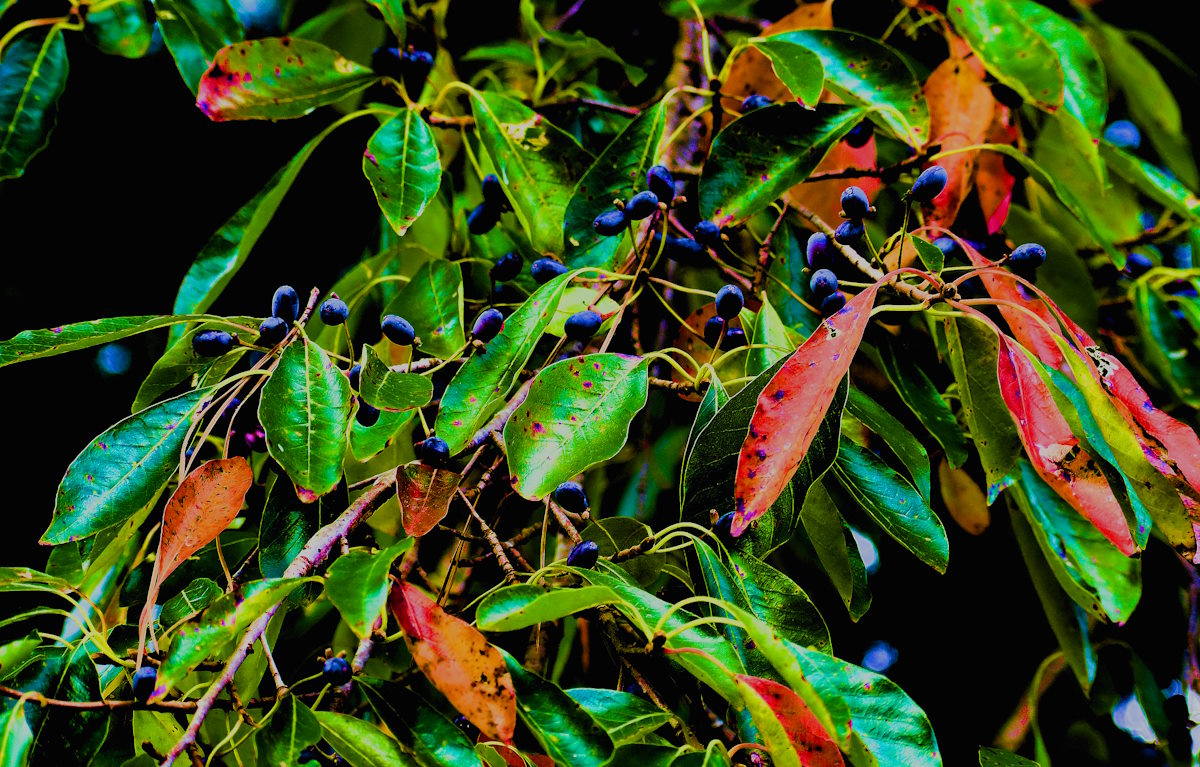
Black gum in Monroe County, Ga. (Terry W. Johnson)
By Terry W. Johnson
A few weeks ago, I accompanied my daughter Angela and her rambunctious husky, Poe, to the city of Forsyth’s dog park. As we sat on a bench watching Poe frolic and investigate hosts of unfamiliar scents, Angela pointed to a tree growing alongside the dog park and asked, “What is that tree?”
We couldn’t identify the tree from where we were sitting, so we walked over for a closer look. Much to my surprise the tree was a black gum (Nyssa sylvatica).
The black gum, which is also called black tupelo, tupelo gum and pepperidge, is one of our most beautiful native trees and a valuable one for wildlife. Although it grows statewide, I cannot remember when I last spotted a black gum in Monroe County. This will probably seem strange to those of you who live in those parts of the state where black gum is far more common. (Experts estimate that black gum trees comprised only 1 percent of the forest in central Georgia prior to this area being settled by Europeans.)
But black gum trees can grow just about anywhere, from floodplains to uplands. The trees also tolerate a variety of soil types. In addition to flourishing in natural settings, the tree does well in yards and urban areas. Consequently, it is no surprise that the Society of Municipal Arborists named it their 2008 Urban Tree of the Year.
The renowned University of Georgia professor of Horticulture, Dr. Michael Dirr, wrote that black gum “is one of our best, most consistent and beautiful trees in the fall.”
Black gum trees can live for more than 450 years. One growing in New Hampshire holds records for being both the oldest black gum and hardwood in the U.S.: It’s over 700 years old.
Black gum trees can reach heights of 100 feet or more. One of the tallest black gums growing in Georgia is a 100-foot giant in Union County. But there’s an even taller one – at 120 feet – in Clarke County.
Some of the traits that endear the tree to homeowners is that it has a straight trunk, rarely splits and displays stunning fall foliage. The fact that the tree has a long taproot and its roots will not buckle sidewalks is a bonus.
Black gum bears abundant clusters of inconspicuous, creamy white flowers in the spring. These blooms attract all sorts of pollinators, especially a wide variety of bees. Black gum is so popular with bees it is sometimes referred to as a bee tree.
The species earns its reputation for spectacular fall foliage by displaying brilliant red leaves. The color is sometimes even referred to as being neon red.
Weeks before the tree dons its fall colors, tell-tail red leaves appear in the dark green canopy. While nobody knows for sure why this happens, some biologists believe that the red leaves help migrating songbirds locate food. Supposedly, they are a sign the tree is bearing a crop of half-inch blue-black drupes.
Since the drupes ripen in late summer, they are an important food source for many fall migrants such as thrushes and tanagers. The sour, half-inch fruits are also eaten by birds such as northern flickers, pileated woodpeckers, mockingbirds, brown thrashers, wood ducks and wild turkeys. They have competition from white-tailed deer, opossums, raccoons, foxes, black bears, fox squirrels and various small mammals.
Black gum trees are a boon for wildlife, too, because they often develop cavities that are used by animals for dens, roosts and nesting sites.
If you are fortunate to have a black gum growing on your farm or woodlands, spare it from the chain saw and axe. Similarly, if there’s a black gum in your yard, consider it a real treasure. It would be hard to find a more beautiful tree that also provides food for so many different kinds of wildlife. And if that isn’t enough, you can make jelly and jam from the fruits.
If black gum sounds like a tree you would like to grow on your property, buy young trees that have the same genotype as the black gums growing in your neck of the woods. If you don’t, you stand the risk of obtaining trees that may not be as colorful as those growing locally may. You can also purchase cultivars. But before doing so, research their qualities for fruiting and leaf color.
If you do transplant black gum trees on your land, protect them from hungry whitetails by protecting them with wire cages. Deer relish the tree’s foliage and branches.
I will never know how the black gum at the dog park survived the major excavation that took place, carving out the park, parking lot and recreation complex. Fortunately, it did, and as a result it has fed generations of migratory songbirds and other wildlife year after year. I daresay that this one tree feed more wildlife annually than any other plants growing in the park.
Also, since I now know about it, I only have to travel less than five miles from my house to enjoy the black gum’s gorgeous fall foliage and perhaps even catch a glimpse of some of the wildlife it attracts.
Terry W. Johnson is a retired Nongame program manager with the Wildlife Resources Division and executive director of The Environmental Resources Network, or TERN, friends group of the division’s Nongame Conservation Section. (Permission is required to reprint this column.) Learn more about TERN, see previous “Out My Backdoor” columns, read Terry’s Backyard Wildlife Connection blog and check out his latest book, “A Journey of Discovery: Monroe County Outdoors.”




















